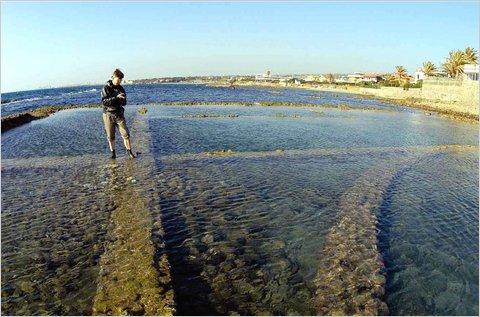Roman decadence and rising seas
Justin Gillis
Source : http://green.blogs.nytimes.com/2010/11/15/roman-decadence-and-rising-seas/?src=me

Fabrizio Antonioli/ENEA The inner dividing walls of a Roman-era fish tank at Punta della Vipera north of Rome. They are now below sea level even at the lowest tide.
Sea level is rising in relation to many of the world’s shorelines, and has been for decades. The main reason is that the volume of the ocean is increasing as a result of the melting of land ice and the warming of the sea itself. (Warm water expands, just as warm air does.)
Scientists once thought this volume increase had been going on, in fits and starts, for thousands of years. This widespread belief was often used as a debating point by climate-change skeptics, who argued that sea-level rise was nothing to worry about because it had existed throughout the history of human civilization.
But research in recent years has turned that notion on its head. The matter is not entirely settled, but some persuasive evidence points to the conclusion that the volume of the ocean was fairly stable for the last 2,000 years and began rising only recently, more or less in sync with industrialization. This is important because it suggests that sea level might be pretty sensitive to the greenhouse gases that humans are dumping into the atmosphere.
I made a brief mention of this issue in a long article on Sunday on sea-level rise but did not have the space to go into much detail. Here is some of the background:
Archaeological discoveries that shed light on ancient sea level are prized finds for the experts in this field. One of the most compelling studies of recent years was carried out by an Australian scientist named Kurt Lambeck, who worked with colleagues in Italy. They focused on ancient fish tanks built at the edge of the Mediterranean by the Romans over the 300 years when their civilization was at its height, ending in the second century A.D.
These tanks were sometimes decorative, but mostly they were used as storage pens to keep fish fresh for the lavish banquets that wealthy Romans held in their seaside villas. The tanks, described in some detail by Roman historians, have long fired the imaginations of classicists, since they represent Roman civilization at its decadent height. The tanks made an appearance in the popular Robert Harris novel “Pompeii,” for instance.
The tanks were usually carved into rock at the edge of the shore and constructed in such a way that some of their features bore precise relationships to sea level at the time. For instance, walls and sluice gates had to be built to let water into the tanks while keeping fish from escaping at high tide. A few years ago, Dr. Lambeck, of the Australian National University, and his team realized that these features could be used to arrive at an estimate of sea level in the time of the Romans.
The work demanded careful measurements, and taking account of land movements in relation to the sea. In fact, this is a factor in sea-level studies the world over, one that greatly complicates the interpretation of features like ancient beaches and coral reefs. Land can rise or sink across a large region as a result of numerous factors, including volcanism, so the sea level in a given place and time depends on how those local factors are intersecting with the global change in ocean volume.
Taking all these factors into account, Dr. Lambeck’s team used the Roman fish tanks to reach the conclusion that global ocean volume had not changed much from the Roman era to the 19th century. That means, in essence, that human civilization reached its present size and complexity during a period when shorelines were reasonably stable in much of the world. Perhaps that explains why so many millions of us are living on those shorelines.
But the longer history of the earth shows that sea level is by no means fixed, as a Columbia University scientist named Robin E. Bell pointed out in my article. The sea surface has gone up and down by hundreds of feet, and it has done so repeatedly as ice ages waxed and waned. The most recent large change occurred at the end of the last ice age. As the ice sheets melted over a period stretching from 20,000 years to 6,000 years before the present, sea level rose by nearly 400 feet.
Now, the volume of the ocean is once again increasing, with an average global rise of perhaps eight inches since the Industrial Revolution. The pace of the increase has recently jumped to about a foot per century, and as I reported in my article, many scientists fear it will increase further, perhaps raising the sea level by an average of three feet by the year 2100 — a challenge for coastal communities worldwide.
Dr. Lambeck, a past president of the Australian Academy of Science, told me the jury was still out on how much of today’s sea-level rise could be attributed to human activities, but he added: “Personally, I feel fairly confident that what we are seeing today is largely an anthropogenic signal.”
For those who want to know more about the Roman tanks and their implications for the global warming debate, this video ( http://www.youtube.com/watch?v=GdfTUdU9x-k ) of a talk by Harvard scientist Jerry X. Mitrovica sheds additional light.

Fabrizio Antonioli/ENEA A sluice gate for a channel controlling the flow of seawater into a fish tank on Ventotene Island, south of Rome, with a modern-day red and white measuring rod. The gate is made of limestone with holes to allow flow during high tide, and it can slide vertically into the stone blocks to the left and right. When it was operating 19 centuries ago, low tide occurred at the level of the base of the sliding block. Today the entire gate is below sea level.